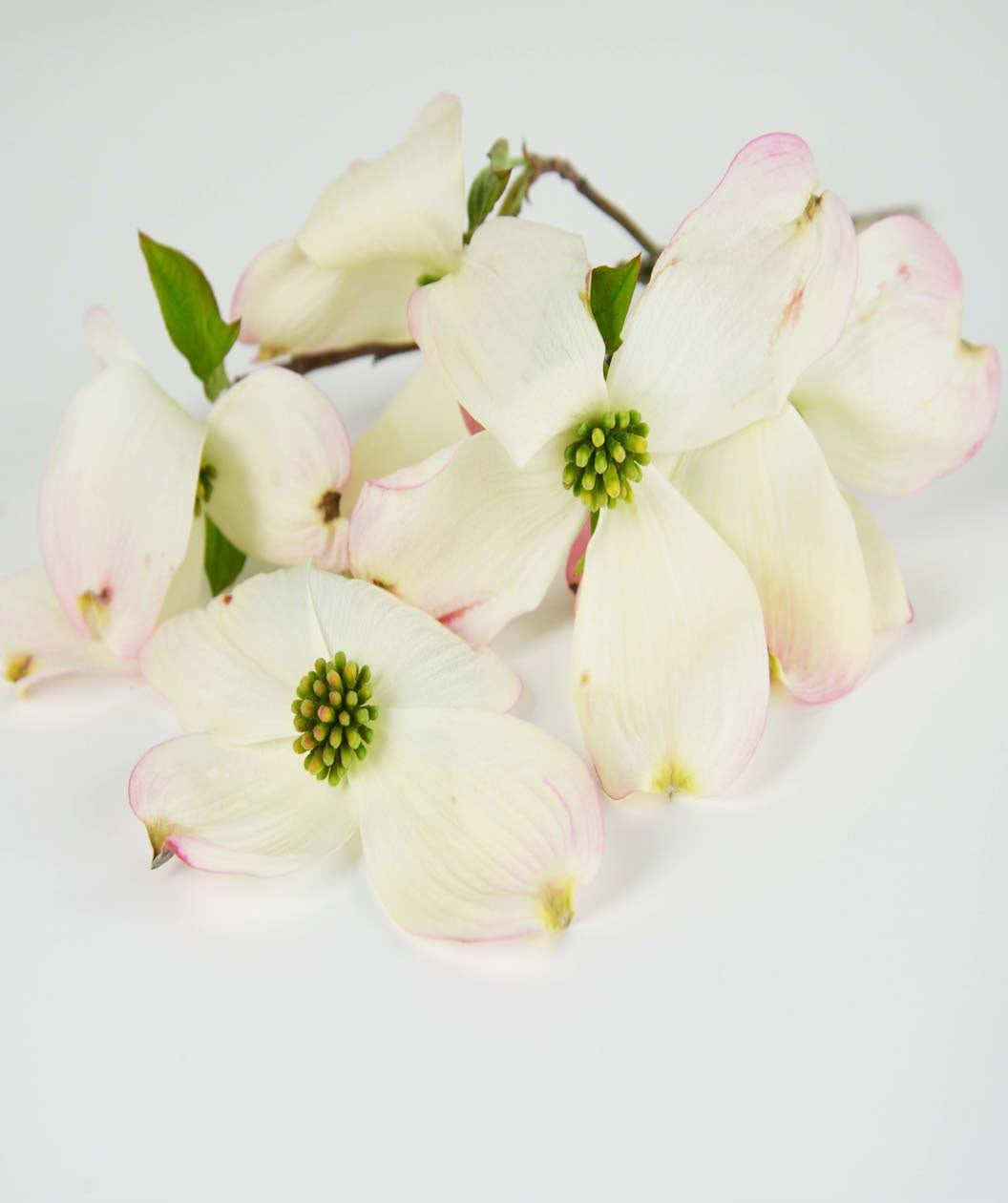


LARGE, CLOUD WHITE FLOWERS AND STUNNING FALL COLOR ON THIS NATIVE DOGWOOD
Features:
- Big, white blooms with light pink edges appear in early spring
- Even from a young age, it blooms heavily
- Dark green leaves transition to a brilliant red to purple color in fall
- Bright red fruits appear in late summer to early fall, providing a tasty tree to local songbirds
- Hand Selected, Fresh from the Grower
- Ships on our trucks because of the size of the tree - does not fit in a box
Growth Facts
- Hardiness Zone: 5-9
- Mature Height: 20-30' tall
- Mature Width: 20-30' wide
- Exposure: Full Sun/Part Shade
- Spacing: 25-30' apart
LARGE, CLOUD WHITE FLOWERS AND STUNNING FALL COLOR ON THIS NATIVE DOGWOOD
Features:
- Big, white blooms with light pink edges appear in early spring
- Even from a young age, it blooms heavily
- Dark green leaves transition to a brilliant red to purple color in fall
- Bright red fruits appear in late summer to early fall, providing a tasty tree to local songbirds
- Hand Selected, Fresh from the Grower
- Ships on our trucks because of the size of the tree - does not fit in a box
Growth Facts
- Hardiness Zone: 5-9
- Mature Height: 20-30' tall
- Mature Width: 20-30' wide
- Exposure: Full Sun/Part Shade
- Spacing: 25-30' apart
Why plant Cloud Nine Flowering Dogwood?
When Cloud Nine Flowering Dogwood opens its profusion of cumulus-cloud-white blossoms each year, it will be the most sensational spring event in your landscape—and probably in your whole neighborhood! Blooming heavily even when very young, this exquisite ornamental tree will wow everybody that sees it, and the show will only get better each year. When the glossy red fruits ripen in autumn, it is the songbirds who will be on Cloud Nine, as the berries are a valuable part of their diet. The fruits aren’t palatable to humans, but rest assured you’ll get your own fall treat in the form of long-lasting burgundy-red autumn foliage.
Flowering Dogwood is a shining star of our eastern forests and woodland edges and has been cherished in this country for centuries. Cloud Nine is a special selection of this treasured native that was introduced in the early 1960s. A man named Henry Chase discovered it on his nursery near Huntsville, Alabama and admired it for its impressive and precocious flower production. Over the years, Cloud Nine has shown itself to be not just a prolific bloomer, but an all-around good “doer”—growers’ lingo for plants that perform especially well without a lot of fuss. It has also proven to be one of the most cold-hardy selections around, despite its southern origins.
How to use Cloud Nine Flowering Dogwood in the landscape?
The true flowers of a Flowering Dogwood are actually the tiny yellow blooms clustered together in the center of the inflorescence. The four “petals” are actually enlarged bracts, like the red bracts on a poinsettia plant.
Your Cloud Nine Flowering Dogwood will be best enjoyed planted near your patio or front window, where you'll experience the blooms in spring, the beautiful fall foliage of reds and purples, and the songbirds that visit for a snack!
Planting Zones
Hardiness Zone: 5-9
How To Plant Cloud Nine Flowering Dogwood
Flowering Dogwoods are vulnerable to a few troublesome pests and diseases, including anthracnose, borers, and powdery mildew. However, proper siting and culture will give your tree a good chance for a long, healthy life. Site your Cloud Nine Dogwood in an area with morning sun and good air circulation, and don’t use overhead sprinklers. Check out our Homeowner’s Guide to Dogwood Diseases and Care for more details, and please do not hesitate to talk to us directly at grower@bowerandbranch.com about any other questions you have concerning Dogwood care.
How To Water
Water twice weekly for the first 3-5 weeks; then water weekly for the remainder of the year until winter. When you water, water slowly and thoroughly. Watering needs may be altered due to extreme weather conditions.
How To Fertilize
Incorporate Elements Starter Plant Food granular form into the soil when planting. If planting in spring or summer, start fertilizing late fall using Elements Starter Plant Food granular form on an annual basis each fall. If planting in the fall, use Elements fertilizer while planting and start your regular annual fertilizing the following fall. Continue this for the first three years to get your plant well established as it gives your tree the nutrients it needs to produce lush new growth for the following spring.
How To Prune
On top of all the great aspects of the Cloud Nine, they really don’t need a lot of pruning! If you feel it’s necessary for a trim, please do so after the tree is done flowering in the spring.
How Does Shipping Work?
Bower & Branch Trees, the real BIG trees, don’t fit in a box! Our big trees, sizes XL and bigger, require expert delivery and care, that means our extra-large trees are shipped on Bower & Branch trucks. We are the only ones who know how to ship our big and bigger trees and plants with tender loving care. We deliver your trees and plants directly to you. Ask Bower & Branch about planting services – we'd be happy to assist in installation.
*For Big trees and Shrubs, Size XL and bigger: Review our Seasonal Shipping Timelines and Policy here.
Your trees and plants are grown across the United States at various Bower & Branch Growers. Depending on your location, your plant orders may be shipped from various locations. Please expect orders with multiple items to be delivered over a number of days as a result. Orders made up of numerous items or selections will not arrive at your home on the same day.
Shipping Delays:
From time to time, Bower & Branch Growers may determine to delay order shipment based on various factors for plant health. Weather in your region, as well as, where your plants are grown, is always considered when shipping. Extreme weather conditions may delay some or all of your order. Bower & Branch allows our Growers to make final shipping decisions based solely to benefit your trees and plants’ health and success.
How Does Sizing Work?
The size of our trees have nothing to do with the container size like you may find elsewhere–big doesn't mean just height - it’s also vigor, age, and overall health. Other online retailers are going to tell you that a plant is a seven gallon, that means nothing to your tree or plant (or you.)
Our trees for sale online are graded on large, x-large, and even bigger sizes. This is because our trees are sized by their age—the higher the letter, the more mature the tree. The age determines the trees’ overall height, size of the trunk and the overall branch density.
All of these characteristics are what you should be looking for when choosing a tree for immediate impact and instant curb appeal. Our extra-large tree and plant sizes are sure to wow you and your neighbors!
See the size guides below.






Our Guarantees
3-YEAR-TREE GUARANTEE:
Bower & Branch offers a Three-Year Tree Guarantee on all of our trees, sizes X-Large and up. Only the finest and the most experienced growers are awarded the opportunity to grow for Bower & Branch, so we offer the best guarantee available.
If your tree(s) should fail for any reason during the three-year guarantee period, you will receive an online gift card in the amount that you originally spent on the tree.* You can then use this online gift card for any Bower & Branch Purchase.
* Bower & Branch provides online gift cards in the amount of the original purchase price of the tree(s). The amount does not include any additional costs such as delivery, planting, tax, or any other products or services. Online gift cards can be applied towards any Bower & Branch purchase on BowerandBranch.com and have no expiration dates. Bower & Branch does not guarantee tree replacement or availability of any desired product at any time. Cash refunds are not offered. Bower & Branch requires that all original tags and receipts are present when a guarantee request is initiated. The Bower & Branch Three-Year Guarantee only applies to plant material that has been planted in the ground. Container plantings are NOT covered.
At Bower & Branch, we do our best to honor all guarantee fulfillment requests to ensure customer satisfaction. However, we reserve the right to refuse the request if the required guarantee steps were not satisfied. Bower & Branch also reserves the right to deny any guarantee fulfillment request that is made as a result of animal damage, problems with plant hardiness and zone issues, or acts of nature (snow storms, hurricanes, and similar).
Reach out to a Plant Whisperer with any questions:
- Email: plantwhisperers@bowerandbranch.com
- Phone: 866-873-3888
- Or via Online Chat




